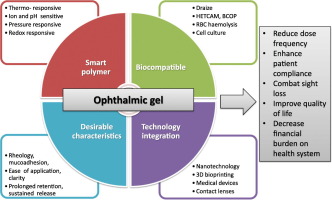Advanced Drug Delivery Reviews ( IF 15.2 ) Pub Date : 2017-12-27 , DOI: 10.1016/j.addr.2017.12.017 Ali A. Al-Kinani , Ghada Zidan , Naba Elsaid , Ali Seyfoddin , Adam W.G. Alani , Raid G. Alany

|
Aqueous gels formulated using hydrophilic polymers (hydrogels) along with those based on stimuli responsive polymers (in situ gelling or gel forming systems) continue to attract increasing interest for various eye health-related applications. They allow the incorporation of a variety of ophthalmic pharmaceuticals to achieve therapeutic levels of drugs and bioactives at target ocular sites. The integration of sophisticated drug delivery technologies such as nanotechnology-based ones with intelligent and environment responsive systems can extend current treatment duration to provide more clinically relevant time courses (weeks and months instead of hours and days) which will inevitably reduce dose frequency, increase patient compliance and improve clinical outcomes. Novel applications and design of contact lenses and intracanalicular delivery devices along with the move towards integrating gels into various drug delivery devices like intraocular pumps, injections and implants has the potential to reduce comorbidities caused by glaucoma, corneal keratopathy, cataract, diabetic retinopathies and age-related macular degeneration. This review describes ophthalmic gelling systems with emphasis on mechanism of gel formation and application in ophthalmology. It provides a critical appraisal of the techniques and methods used in the characterization of ophthalmic preformed gels and in situ gelling systems along with a thorough insight into the safety and biocompatibility of these systems. Newly developed ophthalmic gels, hydrogels, preformed gels and in situ gelling systems including the latest in the area of stimuli responsive gels, molecularly imprinted gels, nanogels, 3D printed hydrogels; 3D printed devices comprising ophthalmic gels are covered. Finally, new applications of gels in the production of artificial corneas, corneal wound healing and hydrogel contact lenses are described.
中文翻译:

眼用凝胶剂:过去,现在和未来
使用亲水性聚合物(水凝胶)以及基于刺激响应性聚合物的凝胶(原位配制)胶凝或凝胶形成系统)继续受到各种与眼睛健康相关的应用的关注。它们允许掺入多种眼科药物,以在目标眼部部位达到治疗水平的药物和生物活性物质。先进的药物输送技术(例如基于纳米技术的药物输送技术)与智能和环境响应系统的集成可以延长当前的治疗持续时间,以提供更多与临床相关的时程(数周和数月而不是数小时和数天),这将不可避免地减少剂量频率,增加患者依从性并改善临床结果。隐形眼镜和小管内输送装置的新颖应用和设计,以及将凝胶整合到各种药物输送装置(如眼内泵)中的趋势,注射和植入具有减轻由青光眼,角膜角膜病,白内障,糖尿病性视网膜病变和与年龄有关的黄斑变性所引起的合并症的潜力。这篇综述描述了眼用胶凝系统,着重于凝胶形成的机理及其在眼科中的应用。它对鉴定眼用预制凝胶和凝胶的技术和方法进行了严格的评估。原位胶凝系统,以及对这些系统的安全性和生物相容性的透彻了解。最新开发的眼科凝胶,水凝胶,预制凝胶和原位胶凝系统,包括最新的刺激响应性凝胶,分子印迹凝胶,纳米凝胶,3D打印水凝胶;覆盖了包括眼科凝胶的3D打印设备。最后,描述了凝胶在人造角膜生产,角膜伤口愈合和水凝胶隐形眼镜中的新应用。











































 京公网安备 11010802027423号
京公网安备 11010802027423号